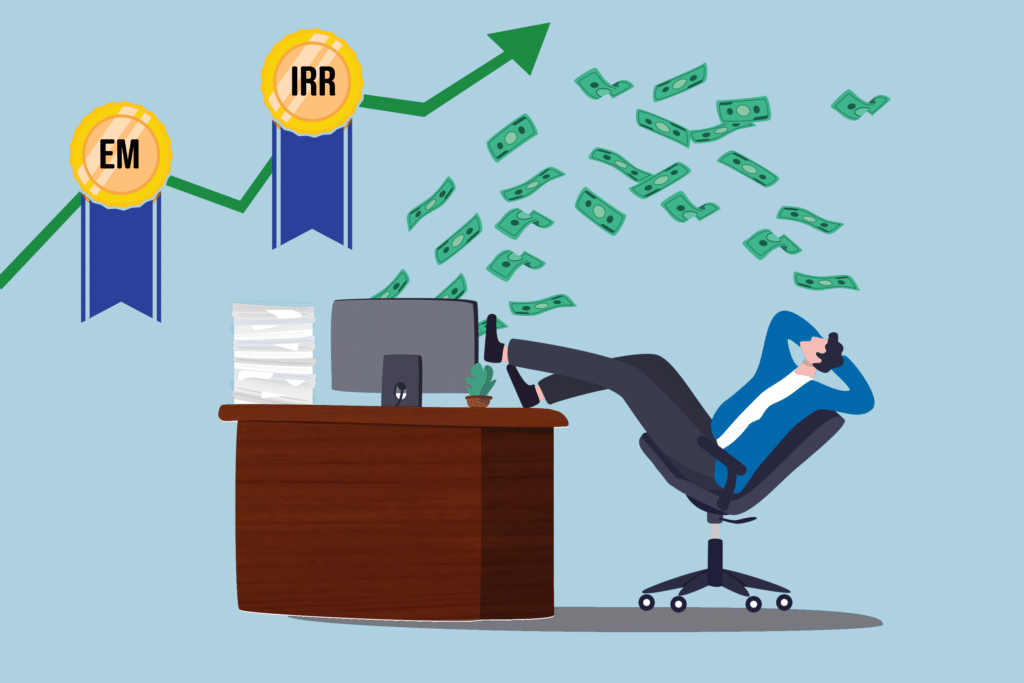
Passive Investment Strategies
Investors embrace passive investment strategies as effective tools for achieving their financial goals. Whether you aim to keep investment costs low, add broad market exposure to your portfolio, or take a hands-off approach, passive investment strategies may be an ideal solution. Let’s look at how passive investment strategies work. We’ll weigh the pros and cons of passive investment strategies, cover recent developments in the space, and explore how to choose the best passive investment strategy for your situation. Additionally, we’ll consider how the “passive” label works in real estate investing.
What are passive investment strategies?
In general, passive investment strategies seek to track a benchmark index and replicate its returns. An index measures the performance of a basket of securities; you can’t invest directly in an index. Typically, no trading is required to maintain a passive investment strategy unless the index composition changes.
A passive equity fund, for example, may seek to track the S&P 500® Index, which represents the 500 largest companies publicly traded on US exchanges. A passive fund benchmarked to the S&P 500 Index would aim to have the same return profile as the index itself.
Passive funds can be tied to a wide variety of indexes—you name it, and there’s probably an index for it. In fact, the Index Industry Association reported there are more than three million indexes globally. Indexes range from those tracking broad market exposure, such as stocks of large European companies, to those focused on specific pockets of the market, such as stocks from emerging markets with high dividend yields, or small-cap stocks meeting certain environmental, social, and governance (ESG) criteria. Passive investment strategies can also be designed to mirror fixed income, commodity, or currency benchmarks.
Some passive fund managers seek to replicate the benchmark index’s performance by buying all the securities within the index. Others use statistical sampling techniques to invest in a subset of the index. Managers can also use derivatives to meet their investment objectives.
Passive vs. active investment strategies
Investors often contrast passive investment strategies against active ones. In an active investment strategy, the manager aims to outperform a given market by picking the most attractive investments. Active managers use their own independent judgment to decide which investments to include and exclude in the portfolio. An active manager will try to beat the returns generated by a benchmark index, whereas a passive manager will try to duplicate the benchmark index’s returns.
Passive investing examples
Investors looking to add equity exposure to their portfolios could buy shares of an exchange-traded fund (ETF) that seeks to replicate the performance of a stock index. That’s exactly what the three biggest ETFs aim to do, each with the objective of tracking the S&P 500 Index. The fourth largest ETF seeks to track the performance of the CRSP US Total Market Index, which covers nearly 100% of the US investable equity market, including large-, mid-, and small-cap stocks across growth and value styles.
As noted above, investors looking for exposure to stocks in specific sectors, industries, and geographies can choose from a wide selection of index-tracking ETFs. Mutual funds also offer the same type of passive, index-tracking equity exposure—just packaged (“wrapped”) in a different investment vehicle.
Similarly, to add fixed-income exposure to their portfolios, investors could buy shares of a mutual fund designed to replicate the performance of a bond index. For large domestic bond funds, a common benchmark index is the Bloomberg U.S. Aggregate Bond Index. Passive bond funds can track all kinds of fixed-income exposures, including corporate, foreign, high yield, investment grade, municipal, inflation-linked, and short-term. Fixed-income passive investment strategies are also available in ETF wrappers.
Pros of passive investment strategies
· Simplicity and transparency – Because passive investment strategies have clearly defined benchmarks that they aim to track, determining what the investment holds and how it fits into your portfolio is usually a straightforward task. While you can certainly trade in and out of passive investment funds based on your market views, many investors choose to use passive investment strategies to pursue a steady buy-and-hold approach, aiming to capture market returns over the long run.
· Lower costs – Passive fund managers aren’t paying for a big team of analysts to hand-pick the most lucrative opportunities. Plus, passive funds aren’t moving in and out of positions in an effort to beat the benchmark, which can reduce turnover rates, transaction costs, and capital gains taxes. Together, these factors can lead to lower overall costs for fund shareholders compared to active investment strategies.
· Lower risk – If you use passive investment strategies to diversify your portfolio across a broad range of investments, then you may benefit from a lower overall risk profile.
· Attractive long-term returns – Foregoing active management and betting on the general market may work out in your favor over the long run. According to the Morningstar Active/Passive Barometer for year-end 2022, only one out of every four active funds outperformed the average returns of their comparable passive peers over a 10-year period.
Cons of passive investment strategies
· Lack of flexibility – A passive fund tracking an index likely has less flexibility than a non-index fund to react to unfavorable conditions, such as price declines or increasing risk. Passive funds also generally lack the ability to hedge or deploy other strategies designed to protect against losses.
· Tracking error and underperformance – A passive investment strategy may not perfectly track its index. Tracking error, fees, and trading cots may cause a passive investment to underperform its benchmark index.
Growth of passive investing
Passive investing has grown substantially to represent a significant portion of the overall investment universe. Several factors are driving the shift to passive, including the inability of active managers to beat public markets, the emergence and growing popularity of ETFs, and a greater focus on fees.
Just how much money is invested passively? The question is open for debate. In the US, measures that focus on index mutual funds and ETFs show about 16% of the stock market is held by passive investors. If the measure is expanded to account for passive investments managed outside of the public universe of index-tracking funds—such as bespoke strategies and direct indexing, usually pursued by savvy institutions—then the figure is much larger. Using this broader measure, researchers found passive investors held at least 37% of the US stock market in 2020.
As the passive investment space grows, commentators and academic researchers are paying close attention to the effects on securities markets, including higher correlation of returns, market price dynamics, and liquidity. Benchmark index dynamics, for example, are coming under greater scrutiny. By choosing a passive global equity fund benchmarked to the MSCI World Index, you might think you’re adding a nicely diversified equity exposure to your portfolio—but the index is heavily exposed to the US and skewed to the technology sector, a byproduct of the fact that the index weights its constituents based on market capitalization. Companies that have been successful see their market caps grow, granting them a bigger weighting in the index—and therefore an outsized impact on index performance and volatility.
A gray area? Non-traditional passive investment strategies
In recent years, mutual fund and ETF providers have introduced many new, non-traditional passive investment strategies. Smart beta funds, which track custom-built indexes, are a relevant example. Smart beta fund managers tilt the portfolio toward one or more factors, such as value, dividend income, or quality. When creating the custom index, managers make active choices about which factors to track and how to systematically track them. Once the rules and index are decided, the strategy is executed passively. As such, many market participants consider smart beta funds a hybrid of passive and active.
Inverse and leveraged funds are another type of non-traditional passive investment strategy. These funds employ a passive investment strategy with the objective of gaining more than 100% exposure to an index and/or gaining inverse exposure to an index. Importantly, these funds are designed to achieve their performance objectives on a daily basis—not over the long term—which makes them markedly different from traditional passive funds and (very) risky for buy-and-hold investors.
A closer look at real estate investments: How do the passive and active labels apply?
Terminology in the investment world can get tricky—and applying active and passive labels to real estate investments is one such instance. The distinction between passive and active is a bit different than what we laid out above for stock and bond investments.
Passive real estate investing is a hands-off strategy in which investors are only responsible for providing capital that other professionals manage on their behalf. As a passive investor, you choose to put money into a real estate investment—and your involvement generally stops there. You’re not involved in buying, managing, or selling the assets; you’re compensating other people to shoulder these ongoing responsibilities. In the eyes of many investors, a key advantage of passive investing is the opportunity to leverage the experience of professional sponsors and operators.
Active real estate investing, on the other hand, is a do-it-yourself approach requiring investors to handle the responsibilities associated with the success of the investment. For example, if you purchase a single-family home as a rental property and are the landlord who manages the repairs and collects rent from tenants, then you are an active real estate investor.
In practice, the differentiations between active and passive run along a spectrum. For example, if you own a rental property but engage a property management firm, your investment slides a bit toward the passive side, although it is still predominately active given your responsibility for overseeing the property manager.
Let’s consider a common example: real estate private equity funds. These vehicles pool together money from investors to deploy across real estate projects in alignment with the goals of the fund. As an individual investor, you’re considered a limited partner (LP). LPs deliver capital, while the general partner (GP) takes responsibility for finding and managing deals to generate an attractive return. Most LPs in private real estate funds are accredited, investors or institutional investors.
As it relates to the management of real estate assets, your role as an individual investor is passive—you’re not directly in charge of toilets, tenants, or trash. The fund, however, is actively managed: the GPs are hand-picking the investments with the objective of achieving a target risk-return profile. The GPs are not simply trying to replicate the return of a specific benchmark. This fund would be considered a passive investment strategy within real estate investment circles.
As a private equity investment company, Trion Properties falls into this category. Our multifamily real estate investment strategy is focused on acquiring opportunistic properties in need of moderate to heavy rehab, with a mid- to long-term investment horizon.
Another example of a passive real estate investment would be an ETF which tracks an index focused on residential properties. The fund seeks to replicate the returns of the index and the ETF shareholders are not involved in day-to-day property management, so we can see how the fund fits within the “passive” category; however, a significant portion of the underlying index may be represented by real estate investment trusts (REITs), which are generally actively managed.
Choosing the best passive investment strategies for your portfolio
Whether you’re considering a passive investment in stocks, bonds, real estate, or another asset class, it’s wise to start with the big picture. Consider your time horizon, risk appetite, and financial goals—these are the foundations for determining the suitability of any given investment. You may want to consult an investment professional to help you understand different investment strategies and how they fit with your objectives.
As suggested by the SEC, you should carefully review all of a fund’s available information. Important resources include the fund’s prospectus and shareholder reports. Before investing in a passive fund, you should have a clear understanding of the following:
· Fees and expenses associated with purchasing, holding, and selling the investment (Check out FINRA’s Fund Analyzer to see how fees and expenses can impact your investment)
· Specific risks associated with the fund
· What types of securities are held by the fund, and how often the portfolio changes
· How the fund achieves its stated objectives
· What the benchmark index contains and how its constituents are determined
· How the fund performs compared to other funds of the same type.

